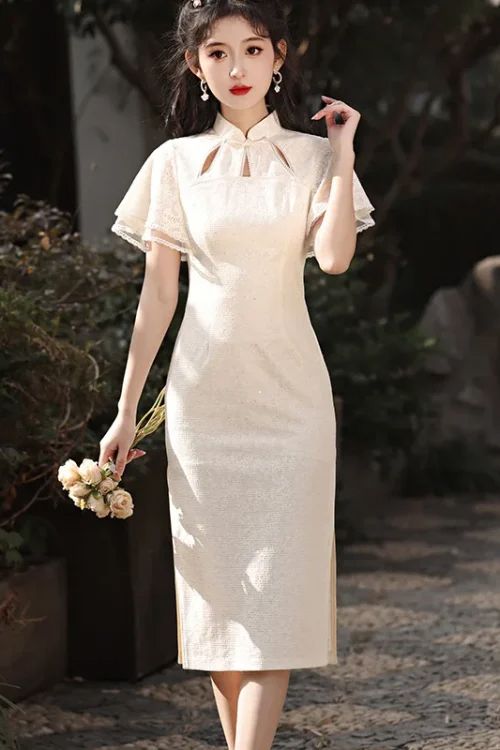Introduction
The qipao, also known as the cheongsam or “mandarin dress” in Cantonese, is a traditional Chinese garment with deep cultural roots. Originating in the city of Changfu, the qipao is a single-piece, tight-fitting dress known for its elegance and historical significance in Chinese fashion. Over time, the qipao has evolved into various styles, but it remains a staple of traditional Chinese clothing for women.

Styles of 旗袍
Cheongsam dresses come in several distinct styles:
- Fitted Cheongsam: The most popular style in China, featuring a straight skirt that tapers at the waist and narrows towards the hem.
- Straight Cheongsam: Similar to the fitted cheongsam but with a straight skirt that doesn’t taper.
- Flared Cheongsam: Characterized by a flared skirt that may be split into two parts for ease of movement.
These styles allow for versatility in wear, from formal occasions to casual gatherings.
Components of the Cheongsam
Typically, a qipao ensemble includes various garments and accessories:
- Qipao Undershirt or Top: A short-sleeved, loose-fitting blouse made from silk or chiffon.
- Qipao Trousers: Tight-fitting trousers crafted from silk or satin.
- Qipao Shoes: Usually high-heeled, made of leather or suede.
Accessories
The qipao is often paired with traditional accessories such as:
- Xiapei: A long piece of fabric draped over the shoulders.
- Yajin: A tassel pendant worn on the pankou knots.
- Qipao Hat: A lace hat with a brim extending from the crown to the forehead.
Defining Elements of a 旗袍
When designing or selecting a qipao, consider these essential elements:
- 材料: Traditional qipaos are made of silk with embroidered designs. Phoenix and dragon motifs are especially popular for wedding qipaos, symbolizing luck and happiness.
- 颜色: Red is the most common color for qipaos, especially in weddings, as it represents good fortune, joy, and happiness. Other popular colors include gold, 白色, 蓝, purple, and 粉红色.
- Mandarin Collar: A hallmark of the qipao, this erect, unfolded collar encircles the neck and typically ranges from two to five centimeters in height.
- Pankou Knots: The traditional knotted buttons, also called frog buttons, are often made of silk or satin and can be as simple or intricate as desired. Phoenix tail pankou knots are frequently chosen for wedding qipaos.
- Top Diagonal: The chest of the qipao is often accented by a series of pankou knots, with a diagonal design that extends from the right armpit to the collar or waist.

Modern Cheongsam Fashion
The qipao has grown beyond its traditional roots, now available in various modern styles such as ankle-length, knee-length, and even mini versions. Modern fabrics and designs have made qipaos a versatile option, from casual daywear to elegant evening attire. These dresses can be paired with modern accessories like pumps, combat boots, or even leather jackets for a contemporary twist.
Cheongsam Accessories
To complete your look, consider accessorizing your cheongsam with:
- Chinese Hairpins: Red and gold hairpins inspired by pankou knots are ideal for updo hairstyles.
- Necklaces: A gold necklace featuring a phoenix and dragon can add symbolic meaning to your outfit, while a delicate jade necklace symbolizes beauty and wisdom.
- Bracelets: Gold or jade bracelets, often featuring dragon and phoenix designs, are popular choices for complementing the qipao.
结论
Whether you opt for a classic qipao or a modern interpretation, this iconic garment allows you to express personal style while honoring Chinese heritage. With endless options for customization in terms of material, color, and accessories, the cheongsam is a timeless choice for both formal and casual settings.
